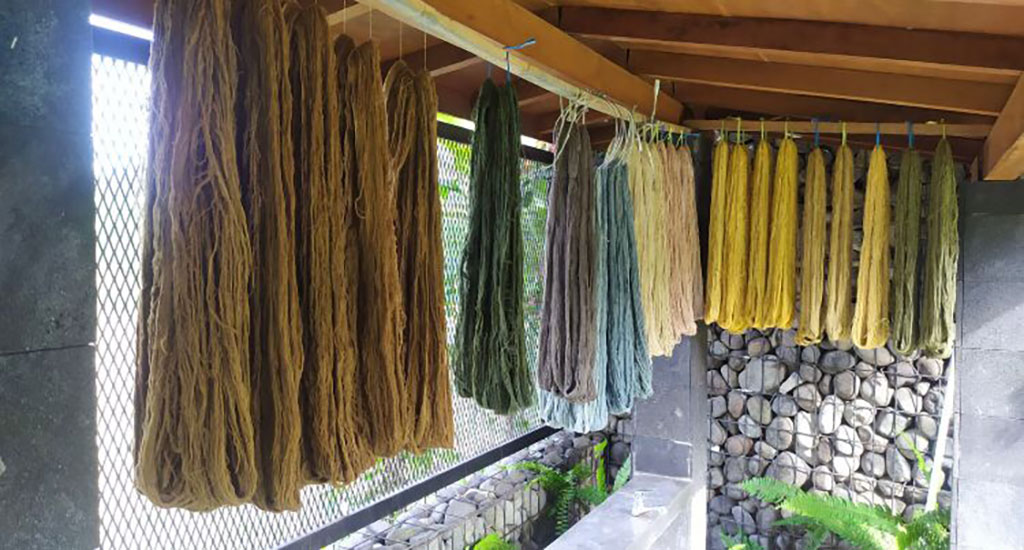“Well, yes, the color changes, Sir!” It was the expression of the ladies when they saw the thread that was white before it was dyed, then turned blue when it was oxidized. A long history shows that the ancestors of the Sasak tribe had good skills in natural coloring. Not only that, in the past they also grew their own cotton and by using the spinning process, they got their own thread that they could use in their daily lives.
Give a check on Indigofera leaves—this plant which can produce blue color has a strong story in it. The conditions in the past where scientific literacy had not yet reached the community led them to several myths in it, including Indigofera plants. Hundreds of years ago, the oxidizable substances of dyes would have been something magical for those who didn’t know how science worked. At that time, many mantras were uttered so that people thought that it was the spell that changed the color of the dyed thread. In addition, the specialty of Indigofera leaves lies in the bacteria that live in them, no wonder it is nicknamed ‘living color’, considering that Indigofera paste can be used several times in the dyeing process and it must be treated by adding sugar water or coconut water in storage.
Dyeing, as an outdoor activity that involves togetherness, kept the weaver ladies excited: green grass on our CLC garden, fresh air, and sunshine work together to create excellent psychological state for them, although thread-dyeing is not a short process.
A little flashback, the facilitators at Titian Rembitan have experienced challenges like the weaver ladies who were hesitant to use natural dyes because the process is both time and energy consuming. However, now they are able to understand that coloring activities not solely bring economic benefits, but it is also fun.

Colored by Collaboration
Back to nature, this spirit more or less became the main topic of our first discussion when we talked with Invest Islands Foundation and Bidadariku. History shows that the weavers of the Sasak tribe possessed good skills in natural coloring. In learning sessions that were held on 27 and 28 July 2022, the weaver ladies received fresh knowledge and immediately practiced natural coloring. They learned about the history of plants that can be used as dyes, the history of weaving, color wheel, mix and match, as well as dyeing techniques presented by Bidadariku.
This session became very interesting because the weaver ladies were asked to explore the natural coloring recipes that were developed by their ancestors. In the practice session, the women were asked to dip the thread in a solution of Indigofera and marigold which produced blue and yellow colors. Then, the dyed Indigofera leaves are dyed into marigolds to produce green color. There was an extraordinary enthusiasm when they saw the color change that occurred. The participants took notes from each steps seriously which can make them be more prepared to color the threads independently in the future.
Not only about natural coloring, the weaver ladies also learned together about the steps to take care of the fabric and do the packaging of the fabric before being sent to the buyer, as well as the use of the technology used in tool for beompok-ompok (thread-winding process) to make the woven fabric production way easier. Aminah, one of the participants said that she was very happy to get new knowledge in terms of natural coloring, this mother of 4 children couldn’t wait to apply her knowledge into practice and produce woven fabrics using her own natural dyed threads. Besides being more environmental-friendly, natural dyed woven fabrics also have higher economic value. Titian Foundation, Invest Islands Foundation and Bidadariku have similar vision in protecting the environment and empowering women, one of which is through weaving activities. Presenting woven products that are good in terms of quality (natural dyes) by not forgetting the cultural values of the community is a big challenge in the modern industrial era.

Long before that, the formation of a group of women weavers from the Rebuk I hamlet of Rembitan village began with a collaboration programme between Soroptimist International of Jakarta (SIJ) and Titian Foundation. We’re breaking the myth circulating in the community that if they weave, they can experience mental disorders, blindness and even death. Now, we have succeeded in making woven fabrics with good quality even to be sold abroad. Not satisfied yet, we continue to develop ourselves to improve the quality and value of the product through learning activities together with collaborative partners who have the same expertise and concentration in the weaving field.
In the end, we knew what makes this process so charming: all the scenes in the dyeing process symbolizes the Rebuk Village residents, they ‘color’ themselves with new knowledge and improving their capabilities in our place.


Titian Foundation, Soroptimist International of Jakarta, Invest Islands Foundation, and Bidadariku are together in empowering all women in Dusun Rebuk I weavers group. You can also participate in our women empowerment in Lombok. (PT/SK)


